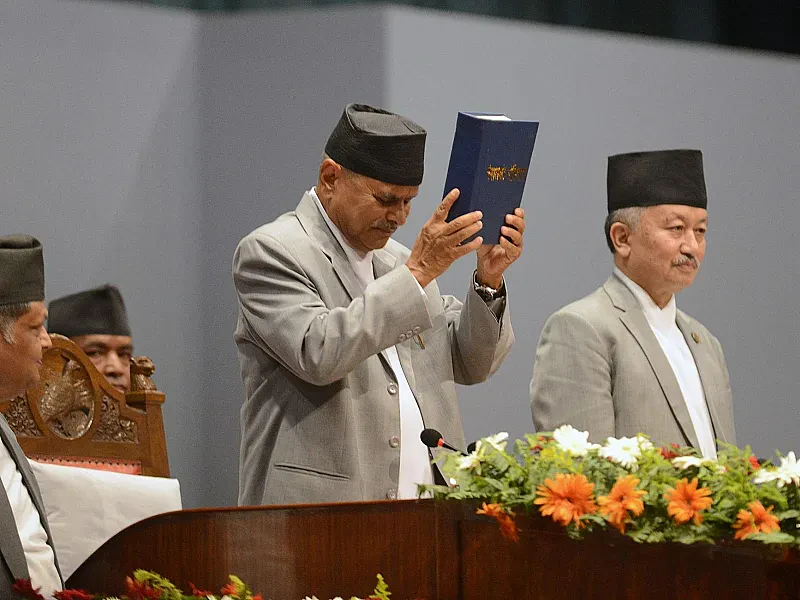
The Constitution of Nepal is the supreme law of the country, which came into effect on 20 September 2015, replacing the Interim Constitution of 2007. The Constitution establishes Nepal as a federal democratic republic with three levels of government: federal, provincial and local. The Constitution also guarantees the fundamental rights and freedoms of the Nepali people, as well as their sovereignty, territorial integrity, national unity, independence and dignity.
The Constitution of Nepal has 35 parts, 308 articles and 9 schedules. Some of the key features of the Constitution are:
- The preamble of the Constitution reflects the aspirations and values of the Nepali people, such as democracy, socialism, secularism, inclusiveness, diversity, peace, good governance, development and prosperity.
- The Constitution defines Nepal as a multi-ethnic, multi-lingual, multi-religious, multi-cultural and geographically diverse nation, and recognizes the right to autonomy and self-rule of its people.
- The Constitution adopts a mixed electoral system for the federal parliament, which consists of two houses: the House of Representatives and the National Assembly. The House of Representatives has 275 members, elected through a combination of first-past-the-post and proportional representation systems. The National Assembly has 59 members, elected by an electoral college composed of members of provincial assemblies and local governments.
- The Constitution provides for seven provinces as the sub-national units of the federal system. Each province has its own legislature, executive and judiciary. The provincial legislatures have 330 members in total, elected through a similar mixed electoral system as the federal parliament. The provincial executives are headed by chief ministers, who are elected by the provincial legislatures. The provincial judiciaries are composed of high courts and subordinate courts.
- The Constitution also provides for 753 local governments as the lowest level of the federal system. These include 6 metropolitan cities, 11 sub-metropolitan cities, 276 municipalities and 460 rural municipalities. Each local government has its own council, executive and judicial committee. The local councils have 35,041 members in total, elected through a combination of first-past-the-post and proportional representation systems. The local executives are headed by mayors or chairpersons, who are elected by the local councils. The local judicial committees are composed of three members each, elected by the local councils.
- The Constitution establishes a presidential system for the federal executive, where the president is the head of state and the prime minister is the head of government. The president is elected by an electoral college composed of members of federal parliament and provincial assemblies. The prime minister is appointed by the president from among the members of federal parliament who commands majority support. The president appoints ministers on the recommendation of the prime minister.
- The Constitution vests the judicial power in an independent and competent judiciary, which consists of the Supreme Court, high courts, district courts and other courts as determined by law. The Supreme Court is the highest court of justice in Nepal, which has 21 judges including the chief justice. The chief justice is appointed by the president on the recommendation of the Constitutional Council. The other judges are appointed by the president on the recommendation of the Judicial Council.
- The Constitution guarantees a range of fundamental rights and freedoms to all citizens, such as equality before law, right to life, right to freedom, right to privacy, right to education, right to health, right to social justice, right to environment and right to constitutional remedies. The Constitution also provides for special rights for women, children, senior citizens, persons with disabilities, Dalits (low-caste communities), indigenous peoples (Janajatis), Madhesis (people from southern plains), Tharus (indigenous people from southern plains), Muslims (religious minority), backward classes (economically disadvantaged groups), marginalized communities (socially excluded groups), farmers (agricultural workers), laborers (industrial workers), youths (young generation), minorities (linguistic or cultural groups) and sexual and gender minorities (LGBTQ+ community).
- The Constitution creates various constitutional bodies and commissions to protect and promote human rights and democracy in Nepal. These include: National Human Rights Commission (NHRC), Election Commission (EC), Commission for Investigation on Abuse of Authority (CIAA), Auditor General (AG), National Natural Resources and Fiscal Commission (NNRFC), National Women Commission (NWC), National Dalit Commission (NDC), National Inclusion Commission (NIC), National Indigenous Peoples Commission (NIPC), Madhesi Commission (MC), Tharu Commission (TC), Muslim Commission (MUC), Backward Classes Commission (BCC), Marginalized Communities Commission (MCC), Farmers Commission (FC), Labor Commission (LC), Youth Commission (YC) and Sexual and Gender Minorities Commission (SGMC).
The Constitution of Nepal is the result of a long and complex process of constitution-making, which involved various actors and stakeholders, such as political parties, civil society, media, experts, international community and the general public. The Constitution was drafted by the Constituent Assembly (CA), which was elected by the people in 2013. The CA had 601 members, representing different political parties, regions, ethnicities, genders and other groups. The CA held several rounds of consultations, deliberations and negotiations to reach consensus on the key issues of the Constitution. The CA also faced many challenges and difficulties, such as political deadlock, public protests, natural disasters and constitutional crisis. The Constitution was finally approved by the CA on 16 September 2015, with 507 votes in favor and 25 votes against. The Constitution was promulgated by the president on 20 September 2015, amid celebrations and criticisms.
The Constitution of Nepal is a historic document that marks the end of a decade-long political transition and the beginning of a new era of federalism, democracy and development in Nepal. The Constitution is also a living document that can be amended and improved to meet the changing needs and aspirations of the Nepali people. The Constitution is a source of pride and hope for the Nepali people, as well as a challenge and responsibility for them to implement it effectively and sincerely.





Comments